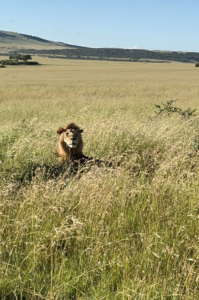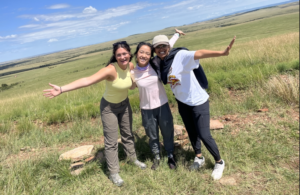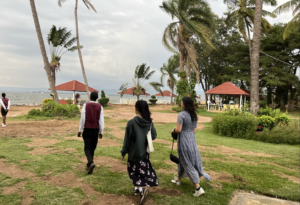 Flew internationally totally alone; bargained for prices; saw a male lion (pictured); saw a dead, half-eaten buffalo that two lionesses just killed (not pictured); ate smokies (a hot dog with tomatoes, onion, and a spicy sauce inside). These are some highlights from my “first time ever” list since leaving the U.S.. Novelty and unfamiliarity were our neighbors for the first two weeks living in Kisumu, Kenya. At the end of the third week, we were off to another “first time ever”: a visit to the Lumumba Hospital. We – okay, hold on.
Flew internationally totally alone; bargained for prices; saw a male lion (pictured); saw a dead, half-eaten buffalo that two lionesses just killed (not pictured); ate smokies (a hot dog with tomatoes, onion, and a spicy sauce inside). These are some highlights from my “first time ever” list since leaving the U.S.. Novelty and unfamiliarity were our neighbors for the first two weeks living in Kisumu, Kenya. At the end of the third week, we were off to another “first time ever”: a visit to the Lumumba Hospital. We – okay, hold on.
“We” refers to my fellow researchers (and now my friends) Isabel and Melat. They are both proud Seattlites (first time ever learning that’s how you refer to people from Seattle) which has led to times where I learn more about Seattle than I do Kenya. We’ve really gelled as a unit no matter how fast I walk, how many limes Melat eats, or how many random romcoms Isabel suggests.

Anyways, we went to the Lumumba Hospital to observe how samples are processed in the lab. At this point, I was used to observing, learning, and asking lots of questions to decode what was always a new environment. I was caught off-guard when the lab technician, Florence, asked us, “With this picture in mind, what are you going to do now?” She had just explained how cultural expectations of gender roles limit women’s ability to come in for treatment. This was well within the scope of our study, but her question still surprised me because this was the ‘first time ever’ that someone had asked something of us.
In many ways I had let the purpose of our trip fade into the background as huge animals and delicious food took center stage. We are here to develop a mobile health app called mSaada which improves access to reproductive care and information for Kenyan women. It was on this day that  Florence reminded us of our unique position as student researchers in another country; it was our job to be helpful despite feeling somewhat helpless in the initial adjustment. A few days after the visit at Lumumba Hospital, we already felt much more confident navigating our surroundings and honed in on the reason we’re here and what we can accomplish. I was particularly energized upon hearing that I would have the chance of accompanying the team for their meeting with the Kisumu East sub-county team at the Gita health facility. I was excited for this solo adventure especially on the heels of the Lumumba Hospital visit.
Florence reminded us of our unique position as student researchers in another country; it was our job to be helpful despite feeling somewhat helpless in the initial adjustment. A few days after the visit at Lumumba Hospital, we already felt much more confident navigating our surroundings and honed in on the reason we’re here and what we can accomplish. I was particularly energized upon hearing that I would have the chance of accompanying the team for their meeting with the Kisumu East sub-county team at the Gita health facility. I was excited for this solo adventure especially on the heels of the Lumumba Hospital visit.
Not so fast. It’s like I could see my professors and supervisors raise their eyebrows collectively. In our preparation for this trip during the past Spring semester, we focused heavily on what it means for us as Americans to go into a foreign country with energy and the desire to help: blindly running into a new space with good intentions does not guarantee good results. There is a recent history of global health projects where the community health partners gain nothing and sometimes end up sacrificing both resources and time on ill-prepared, over-eager researchers. I kept this in mind as I had my first official day in the field.
When it came time for me to accompany the team, I understood that the best thing I could do was be an observer. The meeting at the Gita health facility is part of a larger approval process in which each sub-county we want to work with approves the study and the team’s presence in the area. Approval from the MoH is granted after the study is presented by the team and discussed by the relevant sub-county staff. In this case, Breandan (the study coordinator) was presenting on the mSaada app, while Jeniffer and Purity were presenting other studies.
At the meeting, I found several connections with classes and workshops I attended at Duke. Terms like “stakeholder” became important as the MoH representative mentioned that previous studies did not work because certain demographics of the region were not specifically targeted. I was also reminded of the co-dependent relationship between medicine and global health; innovative medicine has no benefit if people can’t access it. The meeting concluded with a stamp of approval from the MoH rep and the pleasant surprise that the learning from my classes directly applied to this “real world” situation.
MoH representative mentioned that previous studies did not work because certain demographics of the region were not specifically targeted. I was also reminded of the co-dependent relationship between medicine and global health; innovative medicine has no benefit if people can’t access it. The meeting concluded with a stamp of approval from the MoH rep and the pleasant surprise that the learning from my classes directly applied to this “real world” situation.
I had no preparation to lean on for the two site assessments I observed. Accepting my naivete, I was happy to observe once again. The site assessments allow the team to check capability of certain clinics to handle the study’s needs like consistent and quality HPV testing and treatment. The first hospital we were surrounded by mothers and their children. The second was a bit more empty and slightly smaller. At each place we were welcomed and walked through the relevant rooms and equipment. When I got back to the office I realized that even though I was just a pair of inexperienced eyes and ears on that trip, research had indeed been conducted on my end. During our preparation for this trip, we learned that research isn’t always standing behind a glass window with a clipboard running trials. In fact, for studies of this kind it’s usually never like that. I returned to the office with new knowledge of how global health studies are administratively initiated in Kenya and fresh insight into how I can better support the detailed work of the Kisumu staff. I think if I had gone into this field day being eager to insert myself and help, I would not have had such a clarifying and fulfilling day.
We are just now approaching the halfway mark and are just beginning field work. There is more for us to learn and I’m ready for it! Or, at least I feel ready to figure it out – even if it’s for the first time ever. Asante sana!

